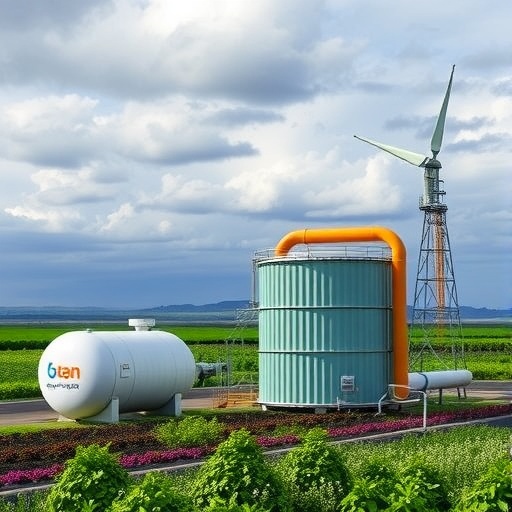In the face of urgent climate challenges and the pressing need for renewable energy solutions, biogas production has emerged as a groundbreaking technology that promises to redefine the future of energy. The process of converting organic waste into biogas not only addresses waste management issues but also harnesses valuable energy in the form of methane. A remarkable study conducted by Narayanaswamy, Noor, and Reddy delves into the vital aspects of sustainable biogas production, notably its energy potential and storage solutions, which can revolutionize the energy landscape.
As the global population surges and urbanization accelerates, the amount of organic waste generated is rising at an alarming rate. Landfills, which are the traditional disposal sites, contribute to greenhouse gas emissions and environmental degradation. In this context, biogas production offers a dual solution: managing organic waste effectively while simultaneously generating energy. Utilizing anaerobic digestion, organic materials such as food scraps, agricultural residues, and even sewage are decomposed by microorganisms in the absence of oxygen, resulting in the production of biogas.
The implications of biogas extend beyond mere energy generation. The residual material left after anaerobic digestion, known as digestate, is an excellent organic fertilizer. This not only contributes to soil health but also reduces the need for synthetic fertilizers, further promoting sustainable agricultural practices. Thus, biogas production encapsulates a circular economy model where waste is transformed into a resource, thus enhancing agricultural productivity while minimizing carbon footprints.
Central to the study by Narayanaswamy and colleagues is the assessment of energy potential. According to their findings, the energy yield from biogas can vary significantly based on the feedstock used and the operational conditions of the biogas facility. For instance, food waste generally yields higher methane percentages compared to agricultural residues. This variability underlines the importance of feedstock selection, which ultimately determines the efficiency and output of biogas production systems.
Moreover, the authors emphasize the necessity of optimizing anaerobic digestion parameters to maximize energy production. Factors such as temperature, pH, and retention time play critical roles in microbial activity and, consequently, in the biogas yield. By adjusting these parameters, operators can significantly enhance the energy output, making the biogas plants more viable and competitive with traditional fossil fuel sources.
Equally important to the energy generation aspect is the storage of biogas, an often-overlooked component in the biogas supply chain. The study highlights various storage options, including gas holders and buffer tanks, which are crucial for managing supply and demand fluctuations. Effective storage solutions are necessary to ensure a continuous energy supply, which can be particularly beneficial in times of high energy demand or when production rates dip due to feedstock availability.
Furthermore, the researchers point out that as the global energy landscape evolves, integrating biogas into the broader energy grid presents both challenges and opportunities. Biogas can be upgraded to biomethane, a purified form of methane that can either be injected into the natural gas grid or utilized as vehicle fuel. This transition requires advanced technologies and infrastructure, calling for greater investments and policy support to ensure biogas can play a significant role in the future renewable energy mix.
The environmental benefits of biogas production extend significantly into the realm of carbon emissions reduction. Conventional fossil fuels release carbon dioxide and other greenhouse gases, exacerbating climate change. In contrast, biogas offers a renewable alternative that, when utilized, can diminish reliance on fossil fuels. In a world grappling with climate crises, embracing biogas production can be one of the key strategies to mitigate its adverse effects.
Additionally, the socio-economic implications of expanding biogas production are profound. Investing in biogas technologies can create jobs in installation, operation, and maintenance of biogas plants. Furthermore, empowering local communities to engage in biogas production promotes energy independence and resilience, particularly in rural areas where access to clean energy sources may be limited. The resulting empowerment can foster sustainable economic development and enhance the quality of life.
Critically, the study also addresses the barriers to scaling biogas systems. Despite the clear advantages, biogas production faces several hurdles, including high initial capital costs, technological gaps, and regulatory challenges. The authors advocate for more supportive policies that encourage the adoption of biogas technology, which could include financial incentives, technical assistance, and educational programs. By lowering the entry barriers for businesses and communities, it is possible to facilitate a broader transition to biogas production and utilization.
As biogas technology continues to evolve, research and innovation will play pivotal roles in its future. Advancements in microbial research, for instance, can lead to more efficient anaerobic digestion processes, while improvements in gas upgrading technologies can enhance the profitability of biogas plants. The ongoing investigation into new feedstocks and innovative digestion methods present exciting avenues for maximizing biogas energy potential, ensuring that this renewable source can meet the ever-increasing demands for clean energy.
In conclusion, the study conducted by Narayanaswamy, Noor, and Reddy elucidates the multifaceted potential of sustainable biogas production as both an energy resource and a crucial component for waste management. By addressing the energy potential, storage challenges, and socio-economic benefits associated with biogas, their findings present a compelling case for a shift towards this renewable energy source. In a world where the climate crisis looms large, embracing and investing in biogas production may not only mitigate environmental impacts but can also pave the way for a sustainable energy future.
The future of energy is rapidly changing, and biogas production represents an essential piece of the puzzle. As research in this field advances, it will unlock new possibilities for harnessing the energy hidden within organic waste, creating a more resilient and sustainable energy landscape for generations to come.
Subject of Research: Sustainable Biogas Production
Article Title: Sustainable biogas production: energy potential and storage aspects
Article References:
Narayanaswamy, N., Noor, M.M. & Reddy, C.M.A. Sustainable biogas production: energy potential and storage aspects. Environ Sci Pollut Res (2025). https://doi.org/10.1007/s11356-025-37097-6
Image Credits: AI Generated
DOI: 10.1007/s11356-025-37097-6
Keywords: Biogas, renewable energy, anaerobic digestion, waste management, sustainability, greenhouse gas reduction, methane, energy storage, circular economy.




